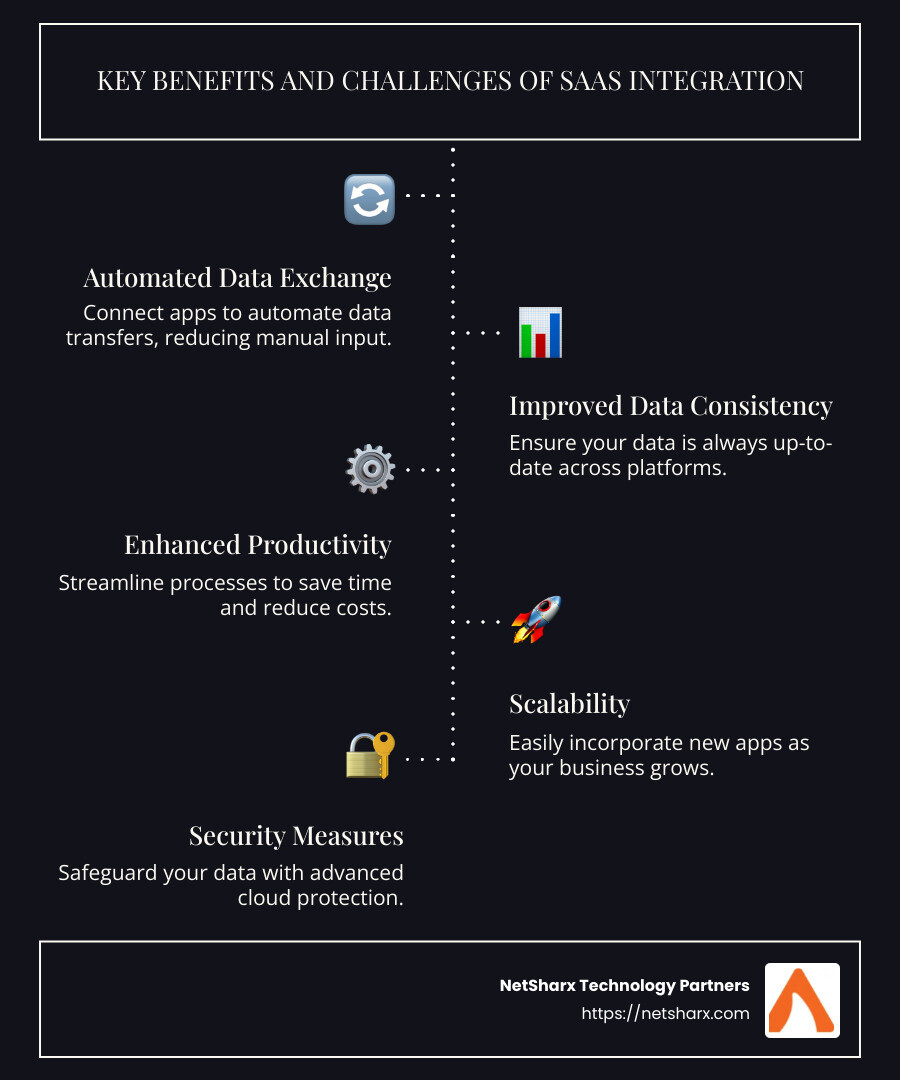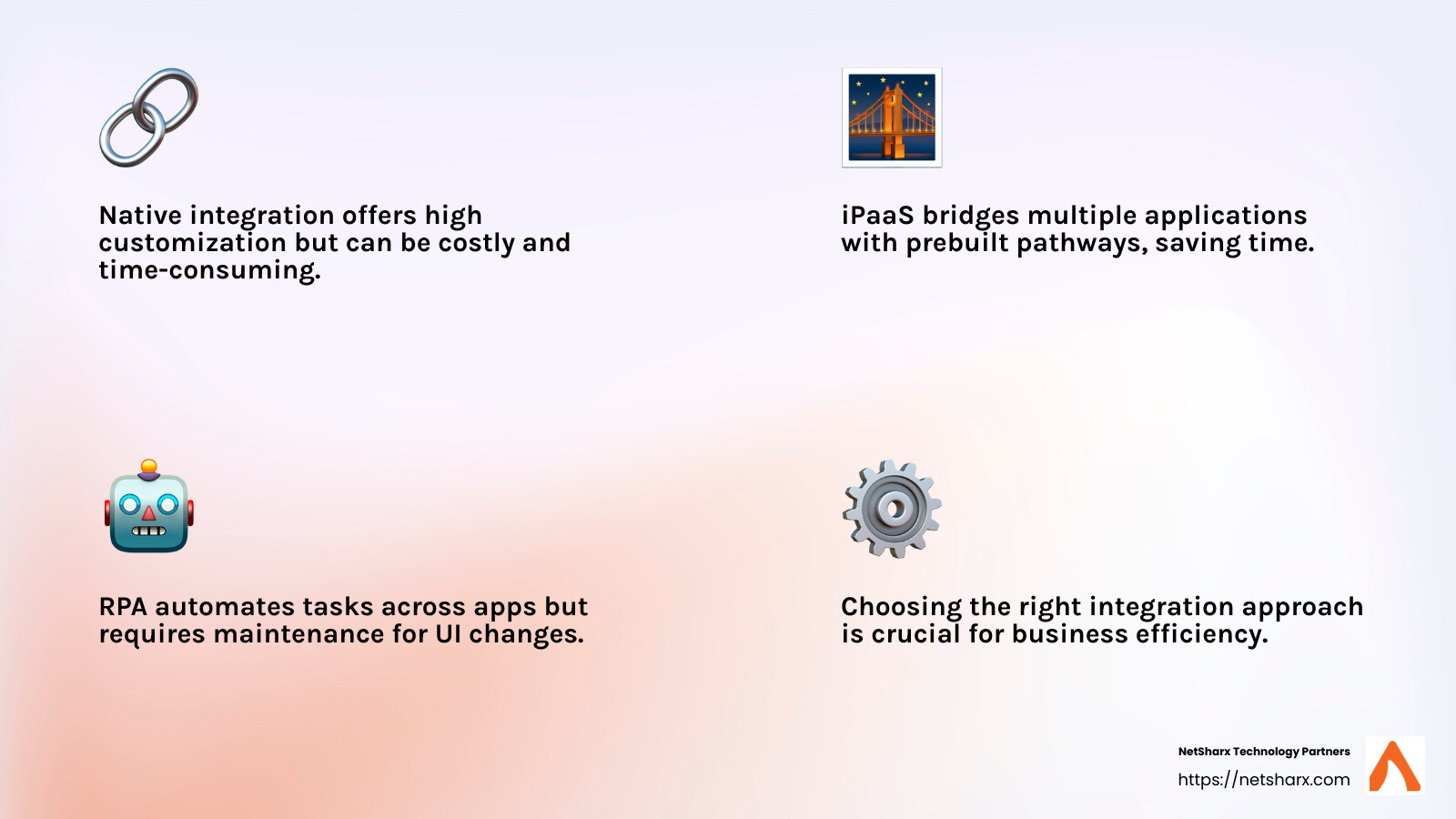SaaS integration services are essential for businesses looking to connect and streamline multiple cloud applications. At its core, SaaS integration involves linking different software-as-a-service applications to facilitate seamless data sharing and improved workflows.
To ensure your tech operations are smooth, here’s what SaaS integration services can offer:
– Automated Data Exchange: Connect various apps to automate data transfers, reducing manual input.
– Improved Data Consistency: Ensure your data is always up-to-date across platforms.
– Improved Productivity: Streamline processes, so you save time and reduce operational costs.
– Scalability: Easily incorporate new applications as your business grows.
– Security Measures: Safeguard your data with advanced protection in the cloud.
By effectively integrating your SaaS applications, you can improve business activities and make data-driven decisions effortlessly.
I’m Ryan Carter. With experience as the founder and CEO of NetSharx Technology Partners, I have guided numerous businesses in adopting SaaS integration services to optimize their digital infrastructure. Stay with us as we explore SaaS integration’s vital role in enhancing efficiency and innovation.
Saas integration services terms explained:
– saas integration platform
– saas integration software
What is SaaS Integration?
SaaS integration is like connecting puzzle pieces in the tech world. It involves linking different software-as-a-service (SaaS) applications so they can work together and share data. This process is crucial for businesses that rely on multiple cloud applications to run their operations smoothly.
APIs: The Backbone of Integration
APIs, or Application Programming Interfaces, are the backbone of SaaS integration services. They are sets of rules that allow different software applications to talk to each other. Think of APIs as translators. They help different apps understand each other, enabling them to share information seamlessly.
-
Data Exchange: APIs enable the exchange of data between applications. For example, when a new customer signs up on your e-commerce platform, an API can send that information to your CRM system automatically.
-
Workflow Automation: With APIs, you can automate workflows, making processes faster and more efficient. For instance, when a sale is completed, APIs can update your inventory system, notify shipping, and send a confirmation email to the customer—all without manual intervention.
Real-Time Updates and Automation
In today’s world, real-time updates are essential. SaaS integration allows for real-time data synchronization, ensuring that all your applications have the most current information. This is especially important for businesses that rely on up-to-date data to make decisions.
-
Triggers: Most SaaS applications come with prebuilt triggers. These are specific actions that, when completed, activate a certain process. For example, a trigger can be set to notify your sales team when a lead reaches a certain score in your marketing platform.
-
Automation: By automating routine tasks, you can reduce errors and save time. Automation allows your team to focus on more strategic tasks, boosting overall productivity.
SaaS integration is a powerful tool for businesses. By linking different applications, you can create a cohesive system that improves productivity and efficiency. As we dig deeper into the benefits of SaaS integration services, you’ll see how these connections can transform your business operations.
Benefits of SaaS Integration Services
SaaS integration services offer a range of benefits that can transform how businesses operate. Let’s explore some of the key advantages:
Increased Efficiency
By integrating various SaaS applications, businesses can automate routine tasks and eliminate manual data entry. This not only speeds up processes but also reduces the risk of errors. Imagine your sales team no longer having to update customer information manually across different platforms. Instead, integration ensures that once data is entered in one system, it’s automatically updated everywhere.
Improved Data Quality
Data silos can lead to inconsistencies and errors. SaaS integration synchronizes data across multiple systems, ensuring a single source of truth. This means that everyone in your organization can access accurate and up-to-date information. Better data quality leads to more informed decision-making and improved business outcomes.
Improved Flexibility
SaaS integration services provide the flexibility to scale operations according to business needs. You can easily add new functionalities or services and integrate them with existing systems. This adaptability is crucial for businesses looking to expand or modify their operations without significant investment in new infrastructure.
Cost Savings
Integrating SaaS applications can lead to significant cost savings. By automating tasks and reducing the need for manual intervention, businesses can cut down on operational costs. Moreover, with data flowing seamlessly between applications, there’s no need to invest in additional tools to access the same information. This is particularly important as businesses strive to optimize their spending on SaaS tools.
As illustrated above, the average business is expected to spend around $3,500 per employee on SaaS tools by 2024. Efficient integration can help manage and minimize these costs.
SaaS integration services are not just about connecting applications; they’re about creating a more efficient, flexible, and cost-effective business environment. By leveraging these services, companies can streamline their operations and focus on strategic growth.
Next, we’ll explore the different approaches to implementing these integrations, including native integration, iPaaS, and RPA.
Approaches to SaaS Integration
When it comes to SaaS integration services, there are a few different paths you can take. Each has its own advantages, and the right choice often depends on your business needs and resources.
Native Integration
Native integration involves building a custom connection between your system and a SaaS application. This approach is like crafting a bespoke suit—it’s custom precisely to fit your needs. While this method offers high flexibility and customization, it can be time-consuming and costly. It’s best for businesses with specific requirements that off-the-shelf solutions can’t meet.
For instance, a company might need to integrate a unique internal system with a popular CRM platform. By choosing native integration, they ensure that every feature and function aligns perfectly with their business processes.
Integration Platform as a Service (iPaaS)
iPaaS is a game-changer for those who want to connect multiple SaaS applications without diving into complex coding. Think of it as a bridge that connects different islands (applications) using prebuilt pathways. Companies like Workato and Boomi offer tools that make it easy to link apps with minimal fuss.
The beauty of iPaaS is in its simplicity and speed. You don’t have to start from scratch, which saves time and effort. However, keep in mind that some technical expertise is still needed for troubleshooting.
Robotic Process Automation (RPA)
RPA uses bots to automate repetitive tasks across applications. Imagine having a digital assistant that copies and pastes information between systems so you don’t have to. This approach is great for automating data entry and syncing information between SaaS apps and internal systems.
However, RPA can be fragile. If the user interface of an application changes, the bots may stop working, requiring hands-on maintenance. While RPA can save time, it’s often better to use it in conjunction with other integration methods.
Choosing the right approach to SaaS integration services can greatly impact your business operations. Whether you opt for the custom fit of native integration, the simplicity of iPaaS, or the automation capabilities of RPA, the goal is to create a seamless flow of data and processes across your applications.
Next, we’ll dive into the challenges you might face when integrating SaaS applications and how to overcome them.
Challenges in SaaS Integration
When diving into SaaS integration services, businesses often encounter several problems. Let’s break down the key challenges: vendor limitations, development challenges, and performance issues.
Vendor Limitations
One major roadblock is vendor limitations. Different SaaS providers use different data formats and APIs. This lack of standardization can make integration tricky. Imagine trying to fit a square peg into a round hole—it just doesn’t work without some adjustments.
For instance, a company using multiple SaaS tools may find that these tools don’t communicate well with each other. This can lead to data silos, where important information is trapped in one system and can’t be accessed by others. To avoid this, businesses must carefully evaluate the compatibility of their chosen SaaS applications.
Development Challenges
Developing custom integrations can be like solving a complex puzzle. It requires specialized knowledge of both the applications being integrated and the technology used. This process can be time-consuming and might need several rounds of development and testing before everything works smoothly.
Moreover, if you’re only relying on one or two developers for a given integration, you’re taking a risk. Should those developers leave, your business may struggle to maintain and improve the integration. To mitigate this, it’s wise to document everything and involve multiple team members in the process.
Performance Issues
Performance is another critical factor. The speed and reliability of data transfer between the SaaS API and your system are crucial. Slow data transfer can frustrate users and disrupt business operations.
For example, synchronizing large datasets in real time can be challenging, especially if there are network issues. Monitoring system health and resolving integration issues requires robust tools and processes. Without these, performance issues can quickly become a bottleneck.
Addressing these challenges requires careful planning, the right tools, and sometimes, a bit of creativity. By understanding these obstacles, businesses can better prepare for successful SaaS integration.
Next, we’ll explore how SaaS integration services work, focusing on APIs, triggers, and real-time updates.
How SaaS Integration Services Work
When we talk about SaaS integration services, three main elements come into play: APIs, triggers, and real-time updates. Let’s break down each one to see how they fit together.
APIs: The Backbone of Integration
APIs, or Application Programming Interfaces, are like bridges. They connect different software applications, allowing them to communicate and share data. Think of APIs as translators that help different programs understand each other.
For instance, when you enter data into an application, an API can send that data to another app, like your CRM system. This ensures your information is always up-to-date across platforms.
APIs use standard formats like XML and JSON to exchange data. This standardization is crucial because it ensures that different systems can “speak the same language” without confusion.
Triggers: The Automation Wizards
Triggers are like the “on” switches in SaaS integration. They activate specific actions when certain conditions are met.
For example, imagine you have an online store. When a customer makes a purchase, a trigger can automatically update your inventory system, send a confirmation email, and notify your shipping department—all without manual input.
These prebuilt triggers save time and reduce errors. They ensure that your business processes run smoothly and efficiently.
Real-Time Updates: Keeping Things Fresh
Real-time updates are all about speed. They ensure that data is instantly available across all your systems. This immediacy is vital for businesses that rely on up-to-the-minute information.
For instance, if you’re managing a sales team, real-time updates can help track performance metrics as they happen. This allows for quick decision-making and better resource allocation.
However, not all SaaS applications offer real-time updates. Some use batch processing, sending data at regular intervals instead of instantly. While this can still be effective, it’s important to choose the right method based on your business needs.
By understanding how APIs, triggers, and real-time updates work, businesses can harness the full power of SaaS integration services. These tools not only streamline operations but also improve data accuracy and collaboration across platforms.
Next, we’ll dive into some frequently asked questions about SaaS integration services.
Frequently Asked Questions about SaaS Integration Services
What are SaaS integration services?
SaaS integration services connect cloud-based applications with other software systems, including on-premise software. This integration allows different applications to “talk” to each other, sharing data and functionality. By doing so, businesses can streamline operations, improve data accuracy, and improve overall productivity.
These services often use APIs to link applications. This means businesses can automate workflows and ensure that all their software tools work together seamlessly.
How does SaaS integration improve business processes?
SaaS integration makes business processes smoother and more efficient through automation and data synchronization.
-
Automation: By automating routine tasks, businesses save time and reduce human errors. For example, when a sales order is placed, it can automatically update inventory levels, send a confirmation email, and generate an invoice—all without manual intervention.
-
Data Synchronization: Keeping data consistent across all platforms is crucial. SaaS integration ensures that when data is updated in one system, it reflects in all others. This reduces discrepancies and ensures everyone in the company has access to the most current information.
-
Error Reduction: Automation and synchronization significantly cut down on manual data entry errors. This leads to more reliable data, better decision-making, and improved customer satisfaction.
What are common challenges in SaaS integration?
While SaaS integration offers many benefits, it also presents some challenges:
-
Security: Sharing data between systems can increase the risk of data breaches. It’s essential to implement strong security measures, such as encryption and access controls, to protect sensitive information.
-
Complexity: Integrating multiple SaaS applications can be complex, requiring careful planning and technical expertise. Each application may have its own data formats and APIs, making integration challenging.
-
Financial Implications: There can be costs associated with integration, such as purchasing additional tools or services. Businesses should analyze these costs against the potential benefits to ensure a good return on investment.
Understanding these challenges helps businesses prepare and implement effective strategies for successful SaaS integration.
In the next section, we’ll explore how NetSharx Technology Partners can provide custom solutions to steer these challenges.
Conclusion
Navigating the complexities of SaaS integration services can be daunting, but with the right partner, it becomes manageable and transformative. At NetSharx Technology Partners, we specialize in providing custom solutions custom to meet your unique business needs. Our unbiased approach ensures that you get the best fit from our extensive provider network, helping you simplify your technology change journey.
Technology Change Made Simple
In today’s digital world, adapting to technological change is not just an option—it’s a necessity. Our team at NetSharx understands this urgency. We offer comprehensive support and competitive pricing, empowering you to accept change with confidence. Whether it’s integrating cloud applications, enhancing data sharing, or automating workflows, our solutions are designed to keep you ahead of the competition.
Custom Solutions for Every Business
We believe that no two businesses are the same, and neither should be their solutions. Our agnostic solution engineering ensures that we focus on your specific needs and desired outcomes. By leveraging our expertise, you can overcome the challenges of SaaS integration, from vendor limitations to performance issues, and achieve seamless connectivity across your software systems.
With our headquarters in Minneapolis, MN, and a commitment to delivering extraordinary service, NetSharx Technology Partners is your trusted ally in achieving efficient, flexible, and cost-effective technology solutions.
Explore how we can help you transform your business here. Let’s make technology work for you.





